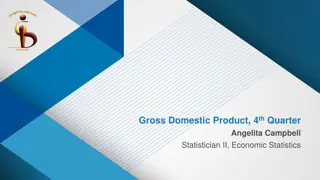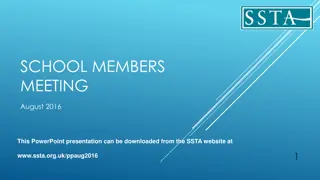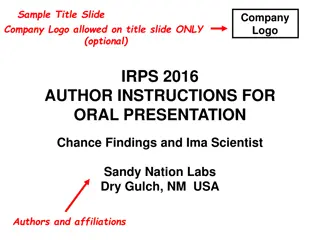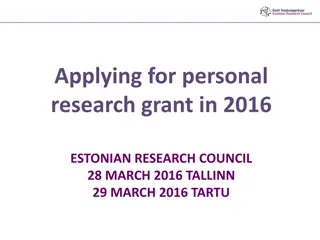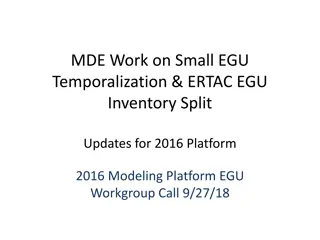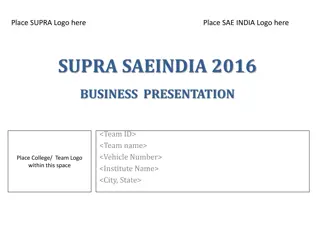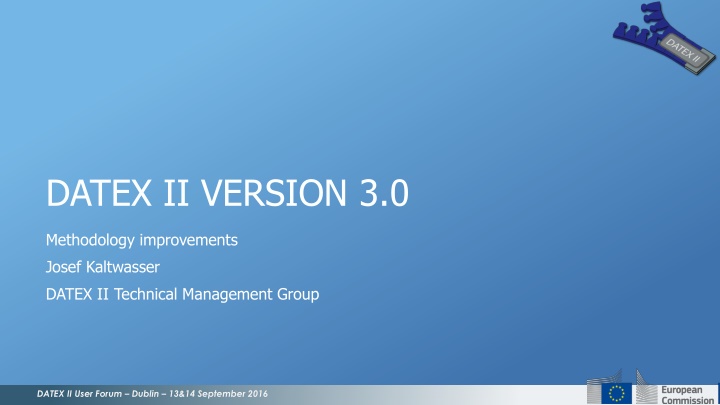
Improvements in DATEX II Version 3.0 Methodology and Features
Explore the enhancements made in the methodology of DATEX II Version 3.0, including improvements in UML 2 and a modular approach. Learn about the lessons learned, clearer meta-model, and the resolution of minor issues, all discussed at the DATEX II User Forum in Dublin. Discover the major improvements in UML 2 for easier processes and tool performance enhancement at the event.
Download Presentation

Please find below an Image/Link to download the presentation.
The content on the website is provided AS IS for your information and personal use only. It may not be sold, licensed, or shared on other websites without obtaining consent from the author. If you encounter any issues during the download, it is possible that the publisher has removed the file from their server.
You are allowed to download the files provided on this website for personal or commercial use, subject to the condition that they are used lawfully. All files are the property of their respective owners.
The content on the website is provided AS IS for your information and personal use only. It may not be sold, licensed, or shared on other websites without obtaining consent from the author.
E N D
Presentation Transcript
DATEX II VERSION 3.0 Methodology improvements Josef Kaltwasser DATEX II Technical Management Group DATEX II User Forum Dublin 13&14 September 2016
RATIONALE DATEX II HISTORY Scrum-ish, agile process Few if any know exactly what has been built Not: We know exactly what we want, go and build it but rather We have built something, now let's see how it works BUT: probably the most open process amongst relevant standards in the domain ( open issue tracker) DATEX II User Forum Dublin 13&14 September 2016
FEATURES OF V3.0 Improved methodology ( lessons learned, from bug reports / feature requests in the issue tracker and beyond) UML 2 ( at last! A much clearer meta-model) Modular approach ( refactored model) Namespaces (getting rid of the global scope for names) A couple of minor issues solved, that were not backwards compatible (in the hard sense of XML validation) DATEX II User Forum Dublin 13&14 September 2016
UML 2 Major improvement, although not necessarily visible at a first glance Improves processes (easier to use) tool performance First proper UML profile: if you need any metaclass eg for extensions just pull it out of the profile DATEX II User Forum Dublin 13&14 September 2016
class UML Profile for DATEX II Name: Package: Version: Author: UML Profile for DATEX II profile UML Profile for DATEX II 3.0 DATEX TG metaclass Package metaclass Enumeration metaclass Attribute metaclass Composition + direction :Direction = Source -> Desti... D2Namespace D2Package D2Enumeration D2Attribute D2Relation D2Literal - - - - prefix :char version :char changed :char definition :char - - - - - changed :char definition :char origin :char originalCode :char originalName :char - - - - - - changed :char = new definition :char origin :char = - null - originalCode :char = - null - originalName :char = - null - regulatoryContext :char - - - - - - - - - - changed :char = new definition :char order :int origin :char = - null - originalCode :char = - null - originalName :char = - null - schemaAttribute :char schemaName :char targetClass :char regulatoryContext :char - - - - - - definition :char order :int origin :char regulatoryContext :char originalCode :char originalName :char - - - - - - - changed :char = new definition :char order :int origin :char = - null - originalCode :char = - null - originalName :char = - null - regulatoryContext :char ExternalNamespace - - - - prefix :char schemaLocation :char namespaceUri :char description :char metaclass Generalization D2ModelRoot + direction :Direction = Source -> Desti... + isSubstitutable :Boolean metaclass Class - - - - - - - - - - - - - rootElement :char extensionName :char extensionVersion :char modelBaseVersion :char = - null - version :char = - null - profileName :char profileVersion :char definition :char regulatoryContext :char changed :char = new origin :char originalCode :char originalName :char + isActive :Boolean metaclass DataType ExternalClass - - schemaName :char description :char D2LevelBExtension D2Datatype ExternalType D2Identifiable D2VersionedIdentifiable D2Class - - - - - - - - - changed :char = new definition :char origin :char originalCode :char originalName :char schemaType :char schemaTypeInclude :char facets :char regulatoryContext :char - - schemaName :char description :char - - - - - - changed :char = new definition :char origin :char originalCode :char originalName :char regulatoryContext :char - - - - - - changed :char = new definition :char origin :char originalCode :char originalName :char regulatoryContext :char - - - - - - changed :char = new definition :char origin :char originalCode :char originalName :char regulatoryContext :char DATEX II User Forum Dublin 13&14 September 2016
16157-1 IMPROVEMENTS Leaner: less narrative parts, especially regarding the early Millennium design rationale Clearer: Abandoned the approach to define own M2/M3 models and map those to UML starting M2 model is now the UML profile More flexible: Modules can be combined in a tailored way DATEX II User Forum Dublin 13&14 September 2016
DATEX IIS HISTORY OF INTEROPERABILITY CONCEPTS Basic concept: Levels A/B/C B extensions compatible Version 1 (early, 2006): B forced modellers to reuse the existing publications extensions were limited; discussions circled around B or C Version 2 (current, 2009+): Introducing GenericPublication everything is Level B discussion circles around A or B Version 3 (future, 2017+): Modules and tools allow diverse interoperability options DATEX II User Forum Dublin 13&14 September 2016
LEVELS OF INTEROPERABILITY Description C1: Minimum C2: Min & tools C3: Min, tools & common Standards 16157-1 16157-1 16157-1 16157-7 16157-1 16157-7 16157-1 16157-7 16157-3(4-6) Documents M, S M, T, S M, T, U, P, S Tools - Profile & tool Profile, model & tool Profile, model & tool Profile, model & tool Recommended No Conditional Conditional B1: Generic M, E, T, U, P, S M, E, T, U, P, S Conditional B2: Publication Yes A1: Profile 16157-1 16157-7 16157-3(4-6) T, U, P, S Model, Tool Yes 16157-1 16157-7 16157-3(4-6) U, S Model, Schema No A2: Full DATEX II User Forum Dublin 13&14 September 2016
FACILITATE CHANGE Current discussions reveal potential need for change, even during the expected lifetime of V3: ASN.1 model representation (ISO/IEC 8824) other transfer syntax options: JSON ASN.1 encoding rules (ISO/IEC 8825, e.g. UPER ISO/IEC 8825-2) The DATEX II Methodology has been improved to cope with such requirements without violating the ENs DATEX II User Forum Dublin 13&14 September 2016
0..* Property Other Stereotype 0..* 0..* Other Metaclass 0..* 0..* Model Concept DATEX II Metaclass 0..* {Association,Attribute, Class,DataType, Enumeration,Generalization, Package,Property} DATEX II Stereotype 1..* DATEX II Property {D2Relation,D2Attribute,D2Class,D2Datatype, D2Enumeration,D2Identifiable,D2LevelBExtension, D2ModelRoot,D2Namespace,D2Package, D2VerionedIdentifiable,ExternalClass, ExternalDatatype,ExternalNamespace} 0..* {PIM: definition, description, extensionName, extensionVersion, modelBaseVersion, order, prefix, profileName, profileVersion, regulatoryContext, rootElement, version PSM: facets, schemaDefinition, schemaLocation, schemaName, schemaInclude} DATEX II User Forum Dublin 13&14 September 2016
CONCLUSIONS DATEX II v3 is evolution, not revolution Flexibility to adapt to emerging requirements Enhanced usability by modular concept Bugs fixed (e.g. allows for including external schemas) Much improved processes and tool performance Migration is beneficial, but the decision for migration should come from functional requirements, i.e. regarding new data concepts DATEX II User Forum Dublin 13&14 September 2016




